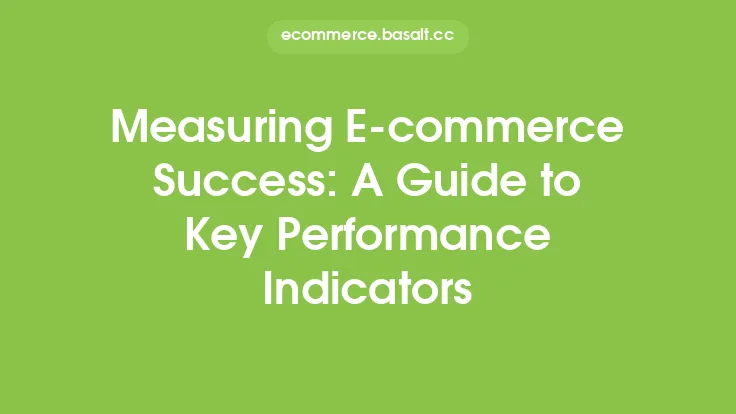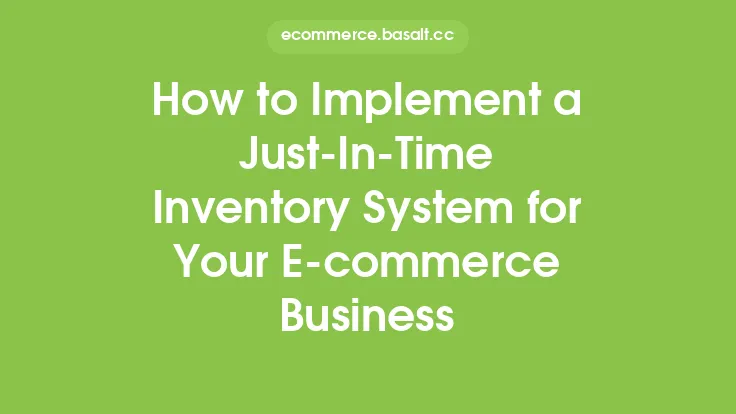In the world of e-commerce, understanding the performance of your online store is crucial for making informed decisions and driving business growth. With the vast amount of data available, it can be overwhelming to determine which metrics to focus on. However, tracking the right e-commerce metrics can help you optimize your store, improve customer experience, and increase revenue. In this article, we will explore the five key e-commerce metrics to track for business success, providing you with a solid foundation for measuring and improving your online store's performance.
Introduction to E-commerce Metrics
E-commerce metrics are quantifiable measures used to evaluate the performance of an online store. These metrics can be categorized into different areas, such as customer behavior, sales, marketing, and operations. By tracking these metrics, e-commerce businesses can identify areas of strength and weakness, set goals, and make data-driven decisions to improve their overall performance. The five key e-commerce metrics to track for business success are: conversion rate, average order value, customer lifetime value, cart abandonment rate, and customer retention rate.
Understanding Conversion Rate
Conversion rate is the percentage of website visitors who complete a desired action, such as making a purchase, filling out a form, or signing up for a newsletter. This metric is essential for e-commerce businesses, as it indicates the effectiveness of their website and marketing efforts in driving sales. A high conversion rate suggests that the website is user-friendly, the product offerings are relevant, and the marketing campaigns are targeted. To improve conversion rates, e-commerce businesses can optimize their website design, simplify the checkout process, and use persuasive calls-to-action.
The Importance of Average Order Value
Average order value (AOV) is the average amount spent by customers in a single transaction. This metric is vital for e-commerce businesses, as it helps them understand the revenue generated by each customer. A high AOV indicates that customers are purchasing more products or higher-priced items, which can lead to increased revenue and profitability. To increase AOV, e-commerce businesses can offer upsells and cross-sells, provide product recommendations, and implement price bundling strategies.
Customer Lifetime Value: A Key to Long-Term Success
Customer lifetime value (CLV) is the total value of a customer to a business over their lifetime. This metric is critical for e-commerce businesses, as it helps them understand the long-term potential of each customer. A high CLV indicates that customers are loyal, make repeat purchases, and provide positive word-of-mouth referrals. To increase CLV, e-commerce businesses can implement loyalty programs, offer personalized marketing campaigns, and provide exceptional customer service.
Reducing Cart Abandonment Rate
Cart abandonment rate is the percentage of customers who add items to their cart but fail to complete the purchase. This metric is essential for e-commerce businesses, as it indicates the effectiveness of their checkout process and the level of customer satisfaction. A high cart abandonment rate suggests that the checkout process is complicated, the shipping costs are high, or the customers are experiencing technical issues. To reduce cart abandonment rates, e-commerce businesses can simplify the checkout process, offer guest checkout options, and provide clear shipping information.
The Power of Customer Retention Rate
Customer retention rate is the percentage of customers who continue to make purchases from an e-commerce business over time. This metric is vital for e-commerce businesses, as it indicates the level of customer loyalty and satisfaction. A high customer retention rate suggests that customers are happy with the products and services, and are likely to make repeat purchases. To increase customer retention rates, e-commerce businesses can implement loyalty programs, offer personalized marketing campaigns, and provide exceptional customer service.
Implementing E-commerce Metrics Tracking
Tracking e-commerce metrics requires the use of analytics tools, such as Google Analytics, that can provide insights into website traffic, customer behavior, and sales performance. E-commerce businesses can also use dashboard tools to visualize their metrics and make data-driven decisions. By tracking the five key e-commerce metrics, businesses can identify areas for improvement, optimize their website and marketing efforts, and drive long-term growth and success.
Best Practices for E-commerce Metrics Analysis
To get the most out of e-commerce metrics analysis, businesses should follow best practices, such as setting clear goals and objectives, tracking metrics regularly, and using data to inform decision-making. E-commerce businesses should also segment their data to understand different customer groups, track metrics across multiple channels, and use A/B testing to optimize their website and marketing efforts. By following these best practices, e-commerce businesses can ensure that they are using their metrics effectively and making data-driven decisions to drive business growth.
Conclusion
In conclusion, tracking the right e-commerce metrics is crucial for driving business growth and success. The five key e-commerce metrics to track are conversion rate, average order value, customer lifetime value, cart abandonment rate, and customer retention rate. By understanding and tracking these metrics, e-commerce businesses can optimize their website and marketing efforts, improve customer experience, and increase revenue. By implementing e-commerce metrics tracking and following best practices for analysis, businesses can make data-driven decisions and drive long-term growth and success in the competitive world of e-commerce.





